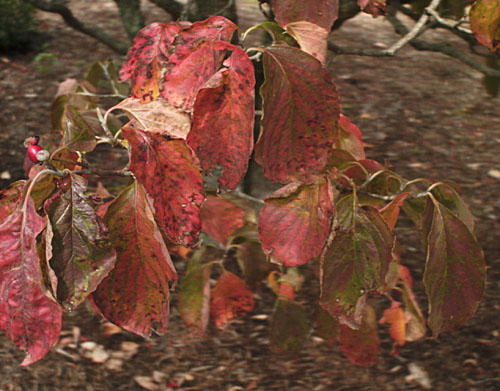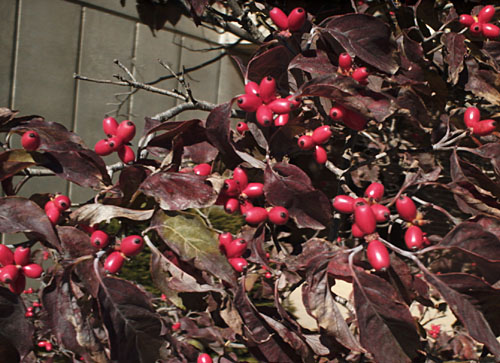Cornus florida
Flowering Dogwood
Cornaceae
ExpandHabitat
- native to the eastern and central United States
- zone 5 with selection of proper genetic material
- grows naturally as an understory tree
Habit and Form
- a small deciduous tree
- grows to about 30' tall with an equal or greater spread
- shape is rounded to somewhat flat-topped
- branching is approaching horizontal
- branches low to the ground with a short trunk
Summer Foliage
- opposite, simple leaves
- oval to ovate shape
- leaves 3" to 6" long
- leaves 1.5' to 3" wide
- leaf color is medium green
Autumn Foliage
- red or reddish purple
- generally quite showy
- colors early and color holds for an extended period
Flowers
- flowers are small and yellowish green
- the showy part of the bloom the four white bracts
- each bract is nearly 2" long
- the diameter of the bracts combined is about 4" across
- bloom time is mid-May
- bloom is effective for 2 weeks
- flowering occurs before leaf out
Fruit
- bright, shiny red fruits
- held in tight clusters of 3 to 4
- each fruit is 0.33" to 0.5" long and elongated
- some trees retain fruit into the winter
- birds often eat the fruit
Bark
- quite attractive
- develops small square or rectangular blocks
- resembles alligator skin
- color is dark gray, brown or black
Culture
- prefers a cool, moist, acidic soil that contains organic matter
- full sun promotes greatest flowering but tolerates partial shade well
- not tolerant of stresses such as heat, drought, pollution, road salt
- best transplanted at a small size
- can be slow to reestablish following transplanting
Landscape Uses
- small groupings
- lawn tree
- specimen
- border
- naturalistic areas
- edge of woods
- patio tree
- has four season appeal in flowers, fruits, fall, color, bark and branching character
Liabilities
- flower buds can be killed or injured by cold in zone 5
- dogwood borer
- dogwood anthracnose
- powdery mildew
- crown rot and canker
- almost overused
ID Features
- flower buds large and flattened
- twigs reddish purple
- alligator-like bark on large branches
- horizontal branching
- white flowers comprised of 4 bracts in May
Propagation
- by seed
- by bud grafting
- by cuttings
Cultivars/Varieties
Dwarf forms (such as 'Compacta') and fastigiate plants (such as 'Fastigiata') are known, but they are rarely available and perhaps best reserved for collectors.
'Cherokee Brave' - Considered one of the best red forms, with deep pink bracts that have a white center. Will grow 15' tall.
'Cherokee Chief' - A popular selection with bracts that are deep red and reddish new growth. The most popular red-pink dogwood.
'Cherokee Daybreak' ('Cherokee Daybreak™) - A variegated selection with white-margined leaves that age to pink in fall. Flower bracts are white.
'Cherokee Princess' - This form blooms at an early age, with very large white flowers -- up to 5" across. It blooms heavily and reliably every year. It's always ranked near the top of dogwood evaluations.
'Cherokee Sunset' (Cherokee Sunset™) - A red-flowered form with variegated foliage that is marked with pink/yellow. A good performer, with strong growth to 25' tall and disease resistance.
'Cloud 9' - A slow-growing cultivar with white overlapping bracts. Very heavy bloomer that starts producing as a young plant. Shows good cold hardiness.
'Pendula' - This rare form features branches that are strongly weeping. Flower bracts are white.
'Plena' - Somewhat of a catch-all name for double, white-bracted forms.
var rubra ('Rubra') - This variety has flowers that range from pink to reddish with considerable variation in color. Very common in the trade.
'Welchii' - The leaves are variegated with a mixture of green, cream and pink. Flowers are white and the fall color is rose red. It benefits from a location in partial shade.
'Xanthocarpa' - A form with unusual yellow fruits and white-bracted flowers.




































